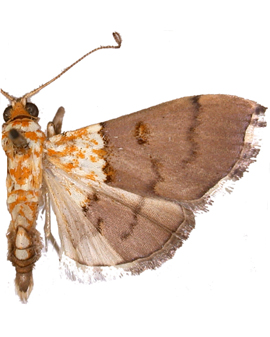Agrotera basinotata Hampson, [1891]; PED 11

-
Taxonomy
The male and female types of Agrotera basinotata Hampson, 1891: 137, pl. 155 fig 13. are from an unknown location. The basinotata ms name was first created by Warren. Hampson (1891) in his description notes that there are other specimens in the BM from NW India.
-
Description
Wing length : 10mm. The basal area of both wings are cream speckled with orange. Distally the wings are a deep purple with brown lineation. The FW margin and fringe is chequered with purple on white. The anal and tornal area of the HW is pale as in many Agrotera spp.
Although distinctively patterned this taxon is part of a sp. complex which needs investigation. In this A. basinotata group there is much minor variation in size, colouration and patterning. Male Agrotera species have elongate abdomens in comparison with the females and sexual dimorphism in patterning may be complicating the situation. It is difficult to separate it from A. posticalis and most other members of the group without reference to the genitalia.
A poor specimen from Kalimantan Timur, (Pasir, Gunung Lumut Protection Forest) in the RMNH Leiden has been DNA barcoded (BOLD; RMNH.INS.19448). -
Distribution & Habitat
Sri Lanka, India (Kerala, Assam, Meghalaya), Burma, Thailand, W. Malaysia, Singapore, Sabah, Indonesia (Kalimantan Timur), PNG, Australia (Q), Hawaii [introd.]. Taiwan, China, Japan. Lowland to lower montane primary forest; <1460m.
-
Life History & Pest Status
Introduced into Hawaii in an attempt to control Melastoma malabathricum. Foodplants M. malabathricum (straits rhododendron or senduduk) (Melastomaceae), Syzygium buxifolium, Syzygium cumini, (Myrtaceae), Sudheendrakumar & Mathew (1999) give Lagerstroemia parvifolia (Lythraceae), Eugenia operculata (Myrtaceae), Pavetta indica (Rubiaceae) Beta vulgaris (beetroot) (Chenopodiaceae) and Brassica oleracea-cultivar group (cabbage) (Brassicaceae).
-
Similar spp.
Agrotera posticalis
Agrotera sp. 8
A. basinotata group
-
Unrelated Look-alike
Superficially similar is Aetholix flavibasalis but this has a white median band in the FW
-
References
Hampson,G.F. (1891) The Lepidoptera Heterocera of the Nilgiri district.. Ill. typ. spec. Lepid. Heteroc. coll. B.M., 8. 144 pp., pl. 139-156, London.
-
Genitalia
no content available.
-
DNA Barcode
no content available.
-
3D Imaging
no content available.
-
Spare
no content available.
KEY TO TABS
(1) Taxonomy, (2) Description, (3) Distribution & Habitat, (4) Life History & Pest Status, (5) Similar spp., (6) Unrelated Look-alikes, (7) References, (8) Genitalia, (9) DNA Barcode, (10) 3D Imaging, (11) Spare

